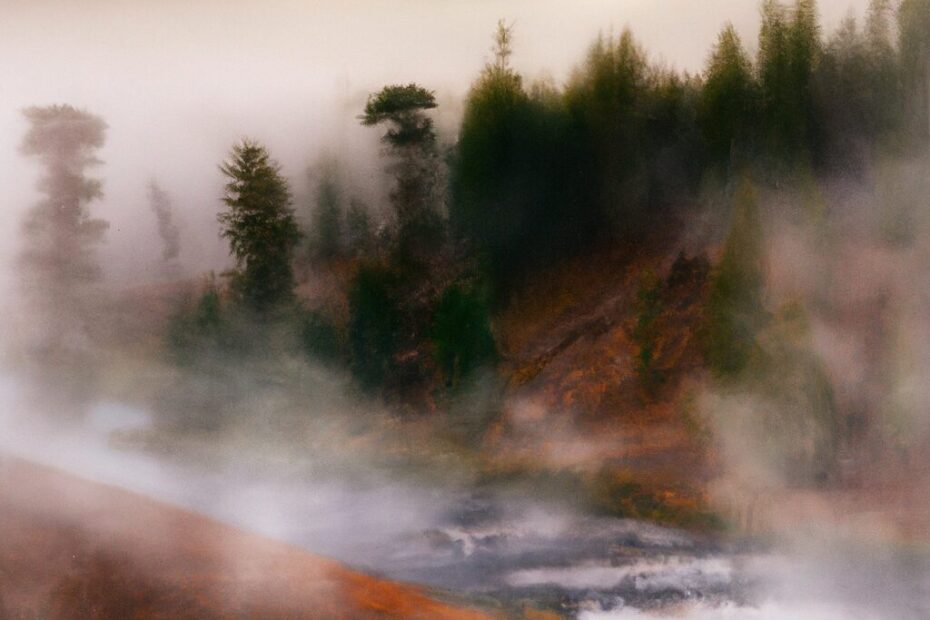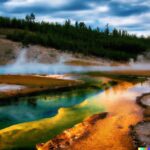Yellowstone National Park is home to some of the most mesmerizing natural wonders, including geysers that shoot hot water and steam into the air. But have you ever wondered how these geysers are formed?
In this article, we will explore the geological processes that give rise to these hydrothermal features in Yellowstone. From volcanic activity to hydrothermal circulation, we will delve into the unique factors that make Yellowstone’s geysers unlike any other in the world.
So, let’s dive in and uncover the secrets behind these incredible natural phenomena.
What Are Geysers?
Geysers are hydrothermal features found in various regions, notably in Yellowstone National Park.
These geysers are unique formations characterized by intermittent eruptions of hot water and steam, often reaching impressive heights. The formation process of geysers involves underground reservoirs of water being heated by magma intruding from Earth’s mantle, creating pressure that eventually forces the water to the surface in explosive eruptions.
In Yellowstone National Park, which boasts over 500 geysers, these hydrothermal features play a significant role in the park’s ecosystem, providing habitats for thermophilic organisms adapted to high temperatures and mineral-rich environments.
Where Is Yellowstone National Park Located?
Yellowstone National Park is situated atop a geological hotspot, where tectonic plates interact to create unique landscapes.
This mesmerizing park covers an area of 2.2 million acres, predominantly located in the U.S. states of Wyoming, Montana, and Idaho. The park’s geothermal features like geysers, hot springs, and mud pots are a direct result of the intense heat generated by the hotspot beneath the Earth’s crust. The tectonic processes, including volcanic activity and earthquakes, contribute to the ever-changing terrain of Yellowstone, showcasing the dynamic relationship between natural forces and the formation of this remarkable ecosystem.
What Makes Yellowstone Unique?
Yellowstone stands out due to its unparalleled geological formations, intense geothermal activity, and mesmerizing thermal features.
The park’s geology is a sight to behold, showcasing unique features such as geysers, hot springs, mud pots, and fumaroles. Each of these geological formations is a testament to the park’s volcanic past and ongoing thermal activity. The diverse range of geothermal activities in Yellowstone creates a dynamic landscape where visitors can witness the power and beauty of nature firsthand.
The park’s captivating thermal features, like the iconic Old Faithful geyser and the vibrant Grand Prismatic Spring, add an element of mystique and wonder to the already awe-inspiring natural environment.
Volcanic Activity
Yellowstone’s volcanic activity is driven by the presence of a vast magma chamber beneath its surface, influencing various geologic processes over time.
This intricate network of molten rock plays a crucial role in shaping the iconic landscape of Yellowstone National Park. When volcanic eruptions occur, the magma from the chamber rises towards the surface, leading to explosive events that can drastically alter the terrain. Over thousands of years, these eruptions have sculpted the geothermal features that make Yellowstone a unique and dynamic environment. The historical timeline of eruptions in the park reveals a pattern of activity that has shaped the land and continues to impact the region to this day.
Hydrothermal Features
The hydrothermal features in Yellowstone, including hydrothermal vents and geothermal heating, showcase the abundant thermal energy beneath the surface.
These features are not just fascinating to explore but also vital in understanding the dynamic geology of the region. Geothermal heating is a process where heat from the Earth’s mantle rises to the surface, creating these unique hydrothermal environments. This distribution of thermal energy fuels the activity of hydrothermal vents, which spew hot, mineral-rich water into the surrounding areas. The interconnectedness of these hydrothermal features within the park forms a delicate ecosystem, supporting diverse microbial life that thrives in extreme conditions. It’s truly a remarkable example of how nature adapts and flourishes in unexpected environments.
What Are the Different Types of Geysers in Yellowstone?
Yellowstone houses a variety of geysers, each unique in its characteristics and behavior, found predominantly in geyser basins featuring geothermal vents.
These geothermal vents play a crucial role in the formation and activity of geysers, providing the necessary heat and underground water sources. The distribution of geysers across the park’s basins showcases the diverse geological features present in Yellowstone.
Old Faithful, one of the most famous geysers, is known for its predictability, shooting water up to 180 feet in the air. Another notable geyser, Beehive Geyser, erupts in a tall, cone-shaped column, captivating visitors with its stunning display of natural power and beauty.
Fountain Geysers
Fountain geysers like the iconic Fountain Paint Pot exemplify the geological wonders of Yellowstone, showcasing mineral deposits and connections to the geothermal reservoir.
These mesmerizing geothermal features are renowned for their vibrant hues, which stem from the various minerals dissolved in the hot water that erupts from the geysers. The connection to the geothermal reservoir beneath Yellowstone provides the immense pressure and heat necessary for these geysers to erupt sporadically in breathtaking displays. The unique geological formations surrounding Fountain Paint Pot, such as the terraces and mudpots, offer a glimpse into the intricate processes at work underground. Visitors marvel at the dynamic interplay of earth’s elements that have shaped these fascinating landscapes over time.
Cone Geysers
Cone geysers in Yellowstone feature distinctive geyser cones formed by silica deposits and interactions with subsurface water sources.
These cone geysers, which are common in Yellowstone National Park, are created when geothermal waters rich in dissolved silica erupt onto the surface. As the water evaporates, the silica is deposited, forming unique cone-shaped structures over time. The presence of subsurface water channels plays a crucial role in regulating the eruptions of these geysers, influencing their behavior and frequency. This combination of silica deposits and subsurface water dynamics results in the mesmerizing spectacle of cone geysers that make Yellowstone a renowned geothermal hotspot.
Geyser Basins
Geyser basins such as the Norris Geyser Basin offer a diverse landscape filled with mud pots, fumaroles, and other hydrothermal features.
Visitors to these remarkable landscapes can witness the bubbling mud pots, which are created by the interaction of hot water and clay-rich sediments, resulting in a thick, sludgy consistency. Fumaroles, on the other hand, are steam vents that release gases such as carbon dioxide and hydrogen sulfide. These striking features not only provide a sensory experience but also play a crucial role in shaping the geology of the Norris Geyser Basin by depositing minerals and altering the surrounding landscape over time.
How Are Geysers Formed in Yellowstone?
The formation of geysers in Yellowstone is intricately linked to the park’s geologic formations, subsurface geology, and the exchange of heat within the Earth’s crust.
Geysers typically form in areas where groundwater comes into contact with hot rocks deep beneath the Earth’s surface. This interaction causes the water to heat up and create pressure as it rises towards the surface. The presence of specific geologic features, such as underground fissures and chambers, plays a crucial role in channeling this heated water upwards.
As the superheated water reaches shallower depths, the pressure release triggers explosive boiling, leading to the iconic eruptions that geysers are known for.
Hotspot Volcanism
The hotspot volcanism in Yellowstone plays a crucial role in shaping the region’s unique geologic model, influenced by dynamic geodynamic processes over time.
This ongoing process of hotspot volcanism has led to the formation of various distinctive geological features within Yellowstone National Park. The continuous upwelling of magma from deep within the Earth’s mantle has created a diverse landscape characterized by geysers, hot springs, and hydrothermal vents. These features are a testament to the active geodynamic processes that have been at play for millions of years. As the hotspot continues to move beneath the Earth’s surface, it drives the dynamic evolution of Yellowstone’s geology, contributing to its ever-changing and fascinating terrain.
Hydrothermal Circulation
Hydrothermal circulation beneath Yellowstone is a complex system driven by hydrogeology, resulting in unique sinter terraces influenced by crustal movement.
This hydrothermal system begins with precipitation infiltrating through Earth’s surface layers and being heated deep underground by the Earth’s mantle. The high temperatures cause the water to rise back up through fractures in the crust, carrying dissolved minerals with it. As this mineral-rich water reaches the surface, it cools and deposits the minerals, creating the colorful terraces seen throughout the park.
The movement of the Earth’s crust plays a crucial role in determining the location and characteristics of these hydrothermal features, showcasing the dynamic interplay between geology and water in Yellowstone.
What Is the Role of Magma in Geysers Formation?
Magma plays a pivotal role in the formation of geysers through dynamic interactions within the magma chamber, supported by geologic evidence and convection currents.
These interactions involve the movement and heating of water in the subsurface regions, leading to the buildup of pressure that ultimately results in geyser eruptions. The convection currents within the magma chamber play a crucial role in transferring heat from the Earth’s interior to the surface, creating the ideal conditions for geyser formation. As magma rises and falls within the chamber, it triggers disturbances in the hydrothermal system, influencing the frequency and intensity of geyser activity. Understanding these complex dynamics is essential for predicting geyser behavior and studying the Earth’s dynamic processes.
Heat Source
Geothermal vents act as the primary heat source for geyser activity, harnessing the intense thermal gradient generated by Yellowstone’s geologic hotspot.
The interaction between the hot rocks underneath Yellowstone and the circulating groundwater creates a unique environment conducive to geothermal energy production. As the scalding hot water rises through the Earth’s crust, it picks up minerals and heat, reaching temperatures well above boiling point. This superheated water then seeks a way to escape, leading to the spectacular eruptions we witness in geysers. The sustainable nature of this geothermal energy cycle not only powers these natural spectacles but also contributes to the overall balance of the geothermal ecosystem.
Pressure Release
The release of pressure within underground conduits triggers steam explosions, a critical process in geyser eruptions and the maintenance of geothermal systems.
These steam explosions play a vital role in the dynamics of geysers, as the sudden release of built-up pressure propels a column of boiling water and steam high into the air. This explosive event not only captivates visitors with its force and beauty but also helps regulate the geyser’s activity. By releasing the pressure accumulated within the underground conduits, steam explosions contribute to the overall balance of the hydrothermal system in Yellowstone National Park. In essence, they are a natural mechanism that upholds the delicate equilibrium of this unique geothermal environment.
What Are the Factors That Affect Geyser Eruptions?
Several factors influence geyser eruptions, including the geyser’s activity levels, the eruption cycle it follows, and the impact of seismic activity on geyser behavior.
Geyser eruptions are often governed by the intricate interplay of these elements. The regular eruption cycles of geysers vary greatly, with some erupting predictably at set intervals while others exhibit more irregular patterns. The activity levels of a geyser, influenced by factors such as underground water levels and temperature fluctuations, play a crucial role in determining when an eruption will occur. Seismic events can have a significant impact on triggering geyser eruptions by disrupting the delicate balance of pressure and heat within the geyser’s underground plumbing system.
Water Supply
The availability of water from groundwater circulation and aquifer systems, along with distinct water chemistry, impacts the frequency and intensity of geyser eruptions.
This interplay between the water supply mechanisms and geyser behavior is crucial in understanding the underlying dynamics of these natural phenomena. Groundwater circulation plays a significant role in replenishing the reservoirs feeding geysers, influencing the pressure build-up necessary for eruptions. The water chemistry, which varies between different geothermal areas, dictates the dissolved minerals present in the water. These minerals can affect the boiling point of the water, contributing to the explosive nature of geyser eruptions. The temperature and pressure changes within the aquifer systems can lead to variations in eruption patterns, showcasing the intricate relationship between water supply and geyser activity.
Underground Plumbing System
The complex subterranean plumbing system in Yellowstone connects mineral springs and deposits geyserite formations, affecting geyser activity and mineral buildup.
These underground conduits, like intricate veins of the Earth, play a crucial role in shaping the unique geothermal wonders found in the park. The network of channels channels mineral-rich water from deep within the Earth’s crust, depositing dissolved minerals along its path. This process contributes to the creation of geyserite, a silica-rich material that lines the walls of geysers and hot springs, ultimately influencing the behavior and eruption patterns of geysers. The mineral deposits left behind by the flowing water contribute to the formation of stunning geological structures, adding to the beauty and complexity of Yellowstone’s landscape.
Thermal Features
The presence of boiling water due to the geothermal gradient contributes to the diverse thermal features observed in Yellowstone, highlighting the dynamic nature of geothermal activity.
This dynamic interplay of heat and water within Yellowstone National Park shapes a unique array of geothermal features, ranging from the iconic geysers like Old Faithful to the bubbling mud pots and colorful hot springs. The geothermal gradient, created by the Earth’s internal heat, drives the circulation of water deep within the ground, heating it to boiling temperatures before resurfacing through various hydrothermal features. These geothermal wonders serve as a constant reminder of the powerful forces at work beneath the park’s surface.
Earthquakes
Earthquakes, monitored through seismic monitoring, play a significant role in crustal deformation and the adjustment of geologic structures crucial for geyser activity.
By tracking seismic data, scientists can detect shifts in the Earth’s crust, providing valuable insights into the underlying geologic processes that influence geyser behavior. This data helps researchers assess the potential risks posed by seismic activity in the Yellowstone region, contributing to early warning systems and hazard mitigation efforts. The dynamic nature of geysers, linked to the intricate interplay between seismic events and crustal deformation, underscores the intricate relationship between geology and seismic monitoring practices in understanding the complex geologic features of Yellowstone National Park.
Last Updated on February 7, 2024 by Jon Waraas – Originally Posted: February 7, 2024

I’m Jon Waraas, and I’ve been navigating the online world since 2006. By day, I’m the proud owner of some eCommerce gems, and by night, I’m the voice behind the adventures on Waraas.Com.
My heart, however, belongs to the wild beauty of Yellowstone National Park. I’ve got a collection of websites dedicated to sharing the wonders of this natural masterpiece. Oh, and did I mention? I’m currently building my own cabin inside the ghost town of Gilmore, Idaho – a cabin with tales to tell!
When I’m not immersed in the digital realm, you’ll find me lacing up my boots for a good hike or setting up camp under the star-studded sky.




